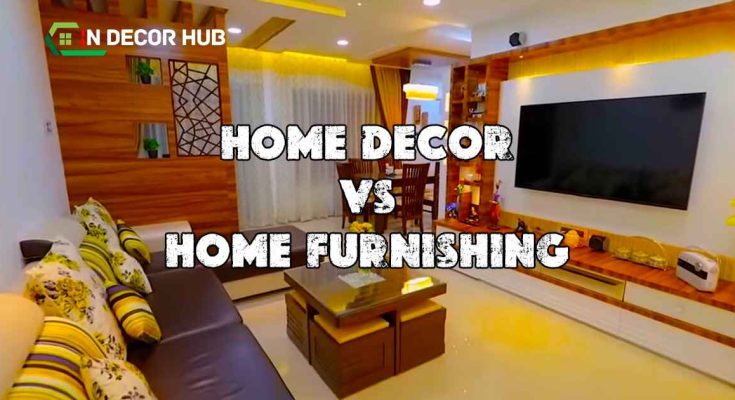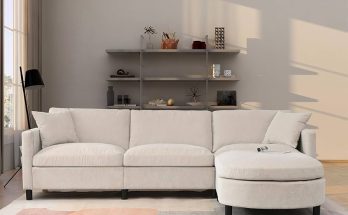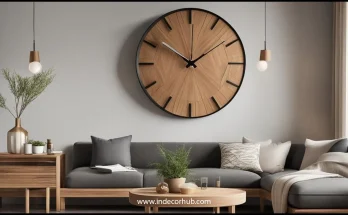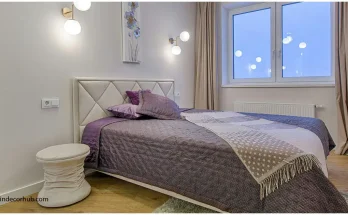Home decor and Home Furnishing are not the same. Home Decor refers to aesthetic components that contribute to the general fashion and environment of space, even as home furnishings include purposeful items like fixtures that facilitate dwelling and comfort in the home.
Decorating a home features a huge spectrum of creative choices, from deciding on color schemes and wall art to choosing the right lighting and add-ons that mirror one’s flavor and lifestyle.
Home decor elevates the visual appeal and creates a desired atmosphere within living spaces. It’s the art of enhancing the interior of a home to acquire aesthetically beautiful surroundings. Home fixtures, then again, are the portions that fill the space, such as sofas, tables, and beds-crucial for everyday features, supplying consolation and application.
Together, domestic decor and fixtures intertwine to form the specific man or woman of a home, illustrating the inhabitant’s fashion whilst making sure of practicality and ease of living. Balancing those factors is key to crafting a harmonious and alluring family.
Table of Contents
Home Decor Versus Home Furnishings: Setting The Scene
Welcome to the heart of your home’s personality. Understanding the difference between home decor and home furnishings can transform your space. Each element tells a part of your house’s story. Together, they create a unique surroundings. Our journey starts off evolving by defining these components.
Setting The Boundaries
Home decor and home furnishings are foundational to your living space. They might seem similar but they serve different purposes.
- The decor includes accents like art and vases.
- Furnishings are essentials like sofas and beds.
Initial Comparisons
| Home Decor | Home Furnishings |
| Wall paintings | Couches |
| Table centerpieces | Bookshelves |
| Decorative lamps | Dining tables |
Digging Into Home Decor
Welcome to the heart of home aesthetics: the alluring world of home decor. Unlike home furnishings which include furniture and functional items, home decor focuses on the visual and stylistic aspects of an interior space. Let’s find out what makes a home visually appealing and uniquely yours.
Defining Home Decor
Home decor is the art of styling your living space to reflect your personal taste and aesthetic preferences. It includes deciding on wall colorations, decorative items, textures, lights, and ordinary spatial layouts to create a cohesive and welcoming atmosphere. This decorative layer personalizes a room and differs from domestic furniture that prioritizes utility and comfort.
Elements Of Style
Understanding the core elements is essential to mastering home decor:
- Color: Sets the mood and ambiance.
- Texture: Adds depth and interest through varied surfaces.
- Pattern: Introduces visual rhythm and focal points.
These elements work together to ensure every room tells its unique story.
| Element | Description |
| Lighting | Manipulates the room’s perceived size and sets the mood. |
| Accessories | Personal touches that embody the homeowner’s interests. |
The World Of Home Furnishings
Welcome to the arena of domestic furnishings-an area where consolation, functionality, and fashion meet. Unlike home decor, which includes elements like wall art and knick-knacks that accentuate the look of a room, home furnishings cover the tangible items that make a house livable and cozy.
Think sofas to sink into, curtains that flutter in the breeze, and pillows to prop you up as you sip your morning coffee. Let’s dive into what makes home furnishings an essential part of shaping the living spaces we love.
Understanding Home Furnishings
Home furnishings are the pieces that fill your home and provide basic comforts. These include a wide range of items:
- Furniture – Tables, chairs, beds
- Textiles – Curtains, bed linens, towels
- Lighting – Lamps, shades, chandeliers
Furnishings vary in style, material, and purpose, catering to different needs and aesthetics. They are investments that you don’t frequently change, so choose wisely!
Functional And Comfort Aspects
Furnishings are not just about filling space. They must be functional and comfortable. A cozy couch provides a space to unwind, while a sturdy table hosts your meals and your children’s homework sessions. The balance between function and comfort is key, influencing your daily life and well-being.
| Item | Function | Comfort |
| Couch | Seating | Soft cushions |
| Bed | Sleeping | Firm mattress |
| Desk | Working | Ergonomic design |
Consider the materials as well. Leather might offer luxury, while cotton ensures easy cleaning. Choose what fits your lifestyle and comfort needs.
Historical Evolution: Decor And Furnishings
Delving into the history of home decor and furnishings unravels a rich tapestry of styles, materials, and practices. Each generation introduced its precise aptitude, responding to the cultural, monetary, and technological climates of the time. The adventure from historical adornments to fashionable minimalist designs displays humanity’s ever-evolving dating with their dwelling spaces.
Decor Through The Ages
The concept of home decor has been integral to human societies since antiquity. Egyptians used intricate wall paintings and ornate furniture to express power. The Greeks introduced strict architectural orders. Medieval homes showcased sober tapestries and woodwork, whilst the Renaissance generation celebrated symmetry and exact motifs.
The Industrial Revolution, presenting the right of entry to new materials and heavily produced gadgets, marked a massive shift, mainly to a brand new diverse variety of decor styles.
Furnishings And Living Spaces
- Stone Age: Simple stone and wood structures, few furnishings.
- Classical Antiquity: Introduction of the bed, chairs, and tables.
- Medieval Period: Heavy oak furniture, multi-functional pieces.
- Renaissance: Ornate carvings, upholstered furniture.
- 19th Century: Industrial manufacturing, affordable decor.
- 20th and 21st Century: Modern, minimalist, sustainability-focused designs.
The evolution of furnishings has been a testament to human innovation. Early furnishings prioritized functionality, whereas modern times have seen a balance of form, function, and comfort.
Today’s homes fuse ancient effects with present-day needs, crafting areas that might be as realistic as they are eye-catching to the attention.
Cultural Influence On Decor And Furnishings
The spaces we call home serve as a canvas. They reflect the rich tapestry of cultures that influence our lives. Home decor and home furnishings are not only about beauty and functionality.
They moreover embody the cultural information and practices of the folks who create and use them. Let’s go for finding how diverse cultures supply away their unique stamp on residing areas around the world.
Global Decorative Styles
Different countries offer a smorgasbord of design aesthetics. These designs transform homes into vibrant reflections of the world’s cultural diversity. Here’s how:
- Scandinavian design champions minimalism, simplicity, and functionality.
- Japanese style prioritizes natural materials and clean lines, echoing Zen principles.
- Moroccan decor dazzles with vibrant colors and intricate patterns, inspiring a sense of exotic escape.
A global mindset can infuse a home with decorative elements from multiple cultures. This fusion creates a rich, eclectic environment that tells a story of journey, heritage, and personal flavor.
Cultural Significance Of Furnishings
Furnishings do more than fill a room. They hold cultural significance and often convey tradition. Here are examples of what furnishings can represent:
| Country | Signature Furnishing | Cultural Impact |
| India | Carved wooden chests | Symbolize craftsmanship and ancestral pride. |
| Italy | Leather sofas | Exemplify luxury and enduring design. |
| Turkey | Ottomans and kilims | Reflect heritage and nomadic traditions. |
Through furnishings, each way of life contributes a unique voice to the tale of home layout. Incorporating those portions can honor traditions and make areas more personalized and impactful.
Impact Of Decor And Furnishings On Lifestyle
The areas we inhabit without delay affect our daily reviews, shaping our moods, productiveness, and standard lifestyle. Understanding this interplay is important while delving into how domestic decor and furniture can redefine our residing environment.
Quality Of Life Improvement
Comfort, functionality, and environment play pivotal roles in improving the niceness of our houses and, with the aid of extension, our lives. Well-chosen furnishings offer more than just utility; they provide comfort and support to our daily routines.
Strategic decor elevates the space, creating an inviting atmosphere that pleases the senses and promotes relaxation.
- Ergonomic furniture reduces strain and fatigue
- Adequate lighting improves mood and focus
- Organizational pieces declutter and calm the mind
Personal Expression Through Design
Our homes serve as a canvas for self-expression. Through colors, patterns, and layouts, we inject our personality into our living quarters. Such personal touches not only make a space uniquely ours but also allow us to feel more connected and at peace within our sanctuary.
| Decor Element | Expression Type |
| Wall Art | Creativity & Inspiration |
| Accent Pieces | Character & Flair |
| Color Schemes | Mood & Energy |
Aesthetics And Functionality: Striking A Balance
Striking the perfect balance between aesthetics and functionality transforms a house into a home. This symmetry ensures that while a home looks inviting, it also serves our daily needs seamlessly. From the furniture we choose to the colors on our walls, each component plays a critical role in creating this harmonious environment.
Aesthetics In Decor
Home Decor focuses on the beauty and style of a space. The right decor reflects the personality and creates a mood. Consider the following elements:
- Color schemes determine the vibe of a room
- Wall art and photographs tell a visual story
- Decorative objects like vases add a touch of elegance
- Light fixtures set the ambiance with brightness and shadow play
Practicality In Furnishings
When it comes to home furnishings, think of comfort and function. These are items we use daily. Key considerations include:
- Comfortable sofas for relaxation
- Dining tables that accommodate the whole family
- Storage units to keep belongings organized
- Beds that offer a good night’s sleep
Finding the optimal blend of décor and furnishing elements is crucial. It requires thoughtful selection and placement. The visual appeal must meet practicality.
Trends Shaping Decor And Furnishings
Exploring the world of home design never gets old. Every year, new trends emerge and we transform our living spaces into exciting places. Let’s explore the latest waves in decor and furnishings. We’ll discover how these elements shape inviting homes.
Contemporary Decor Trends
Simple lines and minimalist designs reign over contemporary decor in 2024. Here’s a snapshot:
- Nature-inspired palettes: Earth tones connect spaces with the outdoors.
- Multifunctional spaces: Furniture doubles as storage or work areas.
- Sustainable materials: Eco-friendly choices are crucial.
Accent walls create focal points. They often feature geometric patterns or textured wallpapers.
Innovations In Furnishings
As technology advances, so do home furnishings. 2024 brings:
| Feature | Description |
| Smart Furniture | Chairs and tables with built-in charging ports. |
| Convertible Pieces | Furniture that adapts to different uses. |
| Ergonomic Designs | Comfort and health guide new furniture shapes. |
Lighting too gets smarter. LEDs with color control set the mood. Hands-free voice commands make life easier.
Choosing Between Decor And Furnishings For Your Space
Are you planning to revamp your space but puzzled over “decor” and “furnishings”? Each plays a unique role in your home’s style and function. Let’s explore how to pick the right one for your haven.
Assessing Your Needs
Determining your needs is the first step.
- Start with the basics.
- List what each room requires.
- Consider comfort, usage, and space.
Look at your lifestyle.
Are there kids or pets?
Think durability.
Choose furnishings to endure daily life.
Creating A Cohesive Look
Creating a visual flow is key.
For a unified home:
- Stick to a color scheme.
- Mix textures wisely.
- Match decor with furnishings.
Select a theme. Keep it consistent.

The Role Of Color In Decor And Furnishings
The use of color transforms any space from ordinary to extraordinary. Color affects mood and ties collectively the factors of each domestic decor and furnishings. Understanding color’s position is important in growing a harmonious home.
Color Theory In Home Design
Color theory guides us on how to use color in our living spaces. It explains how colors interact and the effects they have on a room.
The color wheel is the basis for creating color schemes. There are primary, secondary, and tertiary colors.
- The primary colors are red, blue, and yellow.
- Secondary colors come from mixing primary colors.
- Tertiary colors are from mixing primary and secondary colors.
Understanding warm and cool colors is key.
| Warm Colors | Cool Colors |
| Reds | Blues |
| Oranges | Greens |
| Yellows | Purples |
Warm colors evoke energy, while cool colors are calming.
Using Color To Unify Spaces
Color creates harmony in homes. It connects rooms for a cohesive feel.
Pick a color palette that flows through your home. Use consistent colors in decor and furnishings to unite spaces.
- Select a dominant color for your home.
- Use this color in different items like curtains, rugs, and pillows.
- Add accent colors to introduce variety without clashing.
Balance is key. Too much color can overwhelm you.
Economic Considerations In Decor And Furnishings
Understanding the economic aspects of home decor and furnishings is key. It guides choices and spending. The decor includes items like paintings and vases. Furnishings encompass sofas, beds, and tables. Each has a cost factor. Smart budgeting ensures a balance between style and finance.
Budgeting For Home Improvement
Setting a budget helps avoid overspending. It’s about prioritizing needs over wants. Start by making a list. Categorize items into ‘must-haves’ and ‘nice-to-haves’. Use simple tools like spreadsheets or budgeting apps to track expenses.
- Essential costs: Factor these in first.
- Comparison shopping: Find the best deals.
- Sale seasons: Wait for discounts on big-ticket items.
Investing In Long-term Value
Choose items that last. This means focusing on quality. Furnishings are not only about comfort but also durability. Decor that stands the test of time offers long-term savings. It’s better to spend more now on solid wood furniture than to replace cheap materials later.
| Item | Short-term Value | Long-term Value |
| High-quality sofa | More expensive | Less frequent replacement |
| Artwork | Varies widely | Potential to increase in value |
Remember: Investing in classic designs over trendy pieces ensures your space never goes out of style.
Future Outlook: Sustainability In Decor And Furnishings
As the world embraces a greener future, home decor and furnishings are not left behind. This shift impacts how we design our residences. It respects our planet’s resources. Eco-friendly design choices are gaining popularity day by day. They meet the demand for beautiful and long-lasting homes. Let’s go for exploring these trends.
Eco-friendly Design Choices
Eco-friendly design is more than a trend. It’s a commitment to reduce our environmental footprint. This approach uses items that require less energy and resources. The benefits are multi-fold. It saves our money and promotes a healthier lifestyle. Here are key aspects of eco-friendly design:
- Energy-efficient appliances cut down on electricity use.
- LED lighting lasts longer than traditional bulbs.
- Low-VOC paints ensure better air quality inside your home.
- The use of reclaimed materials adds a rustic charm without harming forests.
Sustainable Materials And Production
Choosing sustainable materials is crucial. Because It makes a big impact on our environment. Here’s what to look for:
| Material | Benefits |
| Bamboo | Grows quickly and requires no pesticides. |
| Recycled Glass | Reduces landfill waste. |
| Organic Cotton | Uses less water and no toxic fertilizers. |
| Reclaimed Wood | Prevents deforestation and has a rich history. |
Responsible production methods are also key. Brands now focus on fair trade and ethical labor practices. This ensures artisans receive a fair wage. It contributes to stronger communities. Look for certifications like FSC for wood and GOTS for textiles. These indicate a commitment to sustainability.
Frequently Asked Questions On The Difference Between Home Decor And Home Furnishings
What Distinguishes Home Decor From Furnishings?
Home decor typically includes aesthetic elements like wall art, plants, and lighting, while furnishings refer to furniture items such as sofas, tables, and chairs.
Can Home Furnishings Be Considered Decor?
Home furnishings can complement decor but are fundamentally functional items, whereas decor primarily enhances the visual appeal of a space.
How Do Home Accents Differ From Furniture?
Home accents, part of the decor, include items like vases and throw pillows that add character to a room, unlike larger, functional furniture pieces.
Is Updating Decor Or Furnishings More Cost-effective?
Updating home decor is generally more cost-effective as it often involves smaller items and accessories, in contrast to purchasing new furniture.
Conclusion
Understanding the nuances of home decor and fixtures complements your capacity to create a cohesive indoor aesthetic. While decor provides persona through accent portions, furnishings offer the functional backbone of any space. Tailoring both elements to suit your taste ensures a harmonious and inviting home.
Remember, balancing form with function is key to a well-designed environment. Choose wisely, personalize creatively, and enjoy your haven to the fullest.



